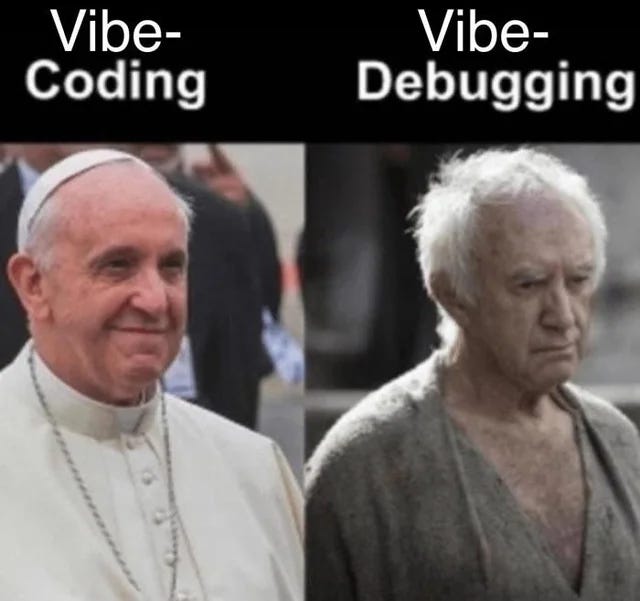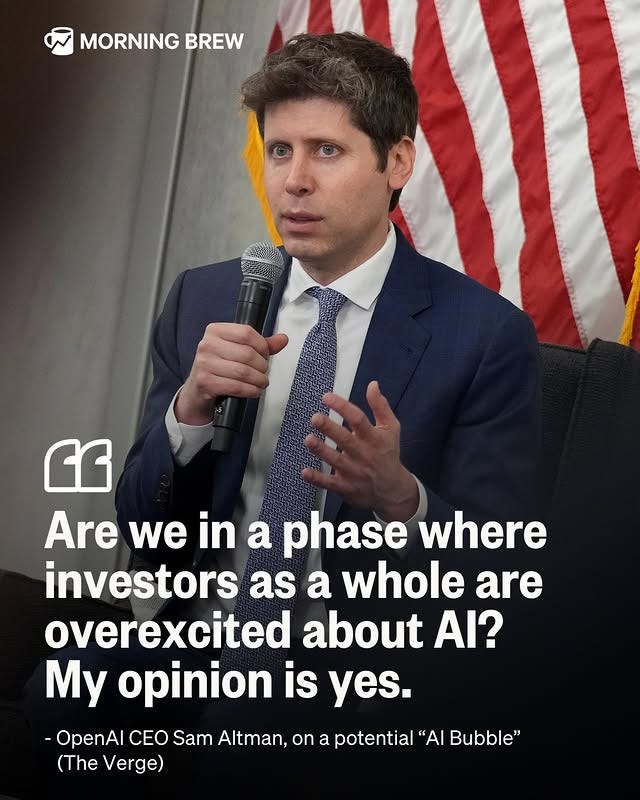Vibe Debugging: Enterprises' Up and Coming Nightmare
and massive B2B opportunities
It's 12:45 PM, and my morning has vanished into the black hole of debugging my vibe-coded meme stock valuation site. The monthly growth numbers are spitting out garbage. What should be a steady 3-5% is showing wild swings between -50% and +2000%; the numbers don't add up.
Each fix attempt means a 3-5 minute wait for Claude Code, get distracted, and come back to find that some code was added, but the bug remains.
To fix this bug, I need to understand the code. However, the code is a mess of duplicates and dead ends, and I’m losing motivation just looking at it.
Frustrated, I decided to give Claude the honor of simplifying this chaos; maybe then I’ll be able to understand what’s happening and fix it myself. While it did successfully simplify some of the code, it also removed one of the application's features.
I embraced defeat, killed the feature, and swore to never think about it again. This is true vibe debugging hell.
Where Things Went Wrong
There are obvious ways to mitigate the need to vibe debug:
Provide the full specification upfront.
Let the agent ask clarifying questions.
Review every change and reject code you don't understand.
But to be honest. When I see a cool product taking shape at lightning speed, it’s tempting to push the limits and ignore the warning signs. The discipline required to use AI tools responsibly is surprisingly difficult to maintain.
I suspect best practices for "vibe coding" will end up like test-driven development: a proven method for writing better software that many engineers still choose to skip.
The Hype is Real
AI agents and LLM-assisted coding can be both a game-changing tool and hyped up at the same time. For example, 81% of developers agreed that AI increases their productivity, but at the same time, you get such delusional interesting takes from very influential figures.
Here is a take that I read from a very well-known venture capitalist:
Vibe coding could reduce the need for open source libraries, as more code will be generated from scratch by AI. Code will be more of a disposable commodity, with less reuse, and instead generated on the fly for personalized use.
Imagine rewriting TensorFlow or React now because code is a disposable commodity.
Picture being a CTO right now: Your board is forwarding you every hot take like this one while your site reliability engineers are having night sweats about potential bugs and security flaws.
Enterprise Tough Position
Enterprises couldn't afford to wait and see with AI coding tools; it was an arms race, and the fear of being left behind was tangible. This gold rush is evident in the rapid adoption of tools like Cursor, reportedly used by over half of the Fortune 500 companies, and WindSurf, which has more than 350 enterprise customers.
But putting these powerful tools in the hands of every developer—from the seasoned architect to the junior engineer—has a predictable side effect: an explosion in code volume. And more code inevitably means more bugs and security flaws. This isn't just speculation. Research has long shown a direct correlation: as the codebase and the number of developers grow, so does the defect density.
Number of developers + Software size → Defect density
Now, consider that with AI, each developer effectively commands a team of tireless virtual programmers. The "number of developers" in that equation isn't just growing; it's multiplying exponentially, and the potential for bugs is multiplying with it.
This forces companies to double down on the very practices designed to ensure quality—rigorous code reviews, static analysis, multi-layered testing, and robust CI/CD pipelines. But these traditional safeguards must also evolve.
Smart enterprises aren't waiting for the next AI breakthrough—they're already building defenses against vibe coding.
The Next Gen Observability
As AI accelerates code production, our ability to observe that code in the wild becomes non-negotiable. Reliable monitoring isn't a luxury; every minute a critical bug lives in production, it's costing money, reputation, or both.
Imagine the 3 AM on-call alert. The engineer trying to fix it might be navigating a section of the codebase they've never seen before, generated entirely by an AI. In this scenario, you can't afford to vibe it out or gamble precious minutes while an AI agent attempts a fix. You need ground truth, and you need it fast.
This is where robust monitoring, especially logging, becomes the bedrock of stability. I've noticed models like Claude are generous with their logging—a fantastic software practice in theory. In practice, however, it creates a tsunami of logs. This is where the industry's DIY approach to log management will break.
The future belongs to sophisticated log analytics platforms that offer intelligent search, anomaly detection, and sensible retention policies, turning that flood of data into actionable insight.
The AI-Proof CI/CD Pipeline
Of course, the best way to handle a production fire is to prevent it from ever starting.
As AI assistants multiply our coding output, our current QA processes simply won't keep pace. This reality will force a massive investment in CI/CD infrastructure. Pipelines will need to evolve from simple build-and-deploy mechanisms into intelligent quality gates.
We're talking about multiple layers of automated testing, rigorous static analysis, and mandatory security scans becoming standard for every single commit. Build times will need to shrink dramatically to accommodate the increased volume of code changes.
This also signals a cultural shift for engineering management. When you can't personally vet every line of AI-generated code, you start managing by proxy. External metrics like code coverage, cognitive complexity, and vulnerability counts will become the primary tools for ensuring that the code hitting production is not just functional, but safe and reliable.
Investing in the Trend
I expect significant growth in B2B SaaS spending as enterprises prioritize safer code deployment and production protection. Public companies in the monitoring (DDOG, DT, etc) and DevOps (GTLB, MSFT, etc) space are well-positioned to capitalize on this shift.
We're also on the cusp of a new startup wave. AI-native monitoring companies are reimagining the developer experience—instead of manually searching through logs, imagine conversing with an AI agent that instantly identifies relevant data and pinpoints issues. While these solutions are still in early stages, I anticipate an explosion of startups that will transform many aspects of software development, mirroring the disruption we witnessed during the cloud revolution.
Isn't it just temporary, and AI will get better?
A common counterargument is: "Isn't this just a temporary problem? AI will get better in a few months."
This assumes linear progress, but AI development follows a pattern of breakthroughs followed by plateaus. The leap from GPT-3.5 to GPT-4 was transformative—everyone noticed. But GPT-5 has been incremental refinements, not revolutions.
The same pattern emerged with coding agents. Initial progress came from raw model improvements, then engineering tricks like Mixture of Agents that pushed capabilities further. But we're now hitting diminishing returns on these approaches. Have we exhausted the low-hanging fruit? Nobody knows when the next breakthrough will come.
Probably only developers working on the best agents out there know how close we are to the next huge leap that would fix their shortcomings. But we can’t trust what they say in public. Sam Altman went from we are a few months away from AGI to claiming that AI is a bubble now.
Until the next breakthrough arrives—whenever that may be—enterprises must build systems for the AI we have today: powerful but unreliable, requiring robust safeguards and human oversight. That's not pessimism; it's prudent engineering.
The takeaway: The enterprise AI wave isn't just changing what tools companies use—it's fundamentally reshaping the entire software development playbook. And whether you're ready or not, that wave is already breaking.




